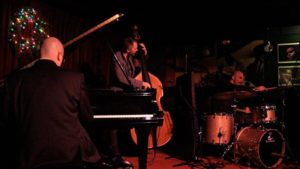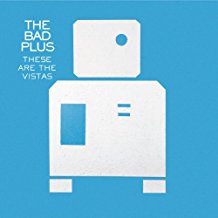 My friend Ethan Iverson, a charter member of the Bad Plus, will be leaving the group on Sunday after they finish a week-long run at the Village Vanguard. I met Ethan in 1999 when I was working on a profile of Mark Morris, for whose dance troupe he was then the rehearsal pianist. Not long after that, Ethan, Reid Anderson, and David King decided to start performing together regularly, and in 2003 they signed with Columbia and put out their first major-label album, These Are the Vistas.
My friend Ethan Iverson, a charter member of the Bad Plus, will be leaving the group on Sunday after they finish a week-long run at the Village Vanguard. I met Ethan in 1999 when I was working on a profile of Mark Morris, for whose dance troupe he was then the rehearsal pianist. Not long after that, Ethan, Reid Anderson, and David King decided to start performing together regularly, and in 2003 they signed with Columbia and put out their first major-label album, These Are the Vistas.
It happens that my Washington Post review of These Are the Vistas was one of the very first pieces about the group to appear in a general-interest publication. Since then, of course, the Bad Plus has long since become one of the most talked-about groups in jazz, and I’m proud to have written about them so early on.
To commemorate Ethan’s departure, I’m posting my 2003 review, which has never been reprinted since it originally appeared in the Post.
* * *
The Bad Plus is a piano trio, one of jazz’s most familiar lineups—only Ethan Iverson, Reid Anderson and David King don’t sound anything like Ahmad Jamal or Oscar Peterson. Instead of the usual show tunes and jazz standards, they play “Smells Like Teen Spirit,” “Heart of Glass,” and weirdly tilted original compositions with titles like “Silence Is the Question” and “Keep the Bugs Off Your Glass and the Bears Off Your Ass.” Their producer is Tchad Blake, whose credits include albums by Elvis Costello, Suzanne Vega and Pearl Jam. And “These Are the Vistas” (Columbia), their major-label debut, isn’t just a breath of fresh air—it’s a tornado.
You probably don’t know any of the members of the Bad Plus by name (unless you happen to be a modern-dance buff, in which case you’ll remember Iverson from his day job as music director of the Mark Morris Dance Group). New Yorkers who keep up with the progressive jazz scene, though, know them as three of the most daring players in town, and when they started working together in 2000, it seemed a pretty safe bet that surprising things were going to happen. The biggest surprise, though, may be that they somehow managed to get Columbia to take an interest in their challenging music. The pop factor is the obvious reason, but the Bad Plus doesn’t do cutesy watered-down covers of hit singles. Instead, they deconstruct the songs of Blondie, Nirvana and Aphex Twin with the same rigorous conceptual clarity that goes into their own originals, and their group sound—blunt, clear-cut, full of splintery dissonances and jolting musical jokes—blends jazz, rock and classical music so indissolubly as to make the differences between the three musics seem trivial.
 Even the recorded sound of “These Are the Vistas” is startling. Though the album was recorded live in the studio without overdubs or edits, Tchad Blake has supplied countless pop-type touches, none of them blatant (a bit of distortion here, an unexpected sonic perspective there) but all of which, taken together, leave no possible doubt that this isn’t your standard piano-trio album.
Even the recorded sound of “These Are the Vistas” is startling. Though the album was recorded live in the studio without overdubs or edits, Tchad Blake has supplied countless pop-type touches, none of them blatant (a bit of distortion here, an unexpected sonic perspective there) but all of which, taken together, leave no possible doubt that this isn’t your standard piano-trio album.
Throughout the past decade, much of the creative energy in American popular music has come from the deliberate hybridizing of seemingly unrelated idioms. This polystylistic approach has been strangely slow to leave its mark on jazz, in which the studied neoclassicism of self-consciously traditional musicians like Wynton Marsalis has been the dominant force since the ’80s. But younger, more adventurous players and composers are jump-starting a music that once seemed to be dead in the water, and with the release of “These Are the Vistas,” the Bad Plus has catapulted to the front of their ranks. A few older pianists, among them Keith Jarrett and Fred Hersch, have continued to make distinctive use of the piano-bass-drums lineup, but no one under 40 was saying anything remotely new with the format—until now. If you want to know where jazz is headed next, look here.
* * *
The Bad Plus plays “Smells Like Teen Spirit” live in Hollywood in 2008:
